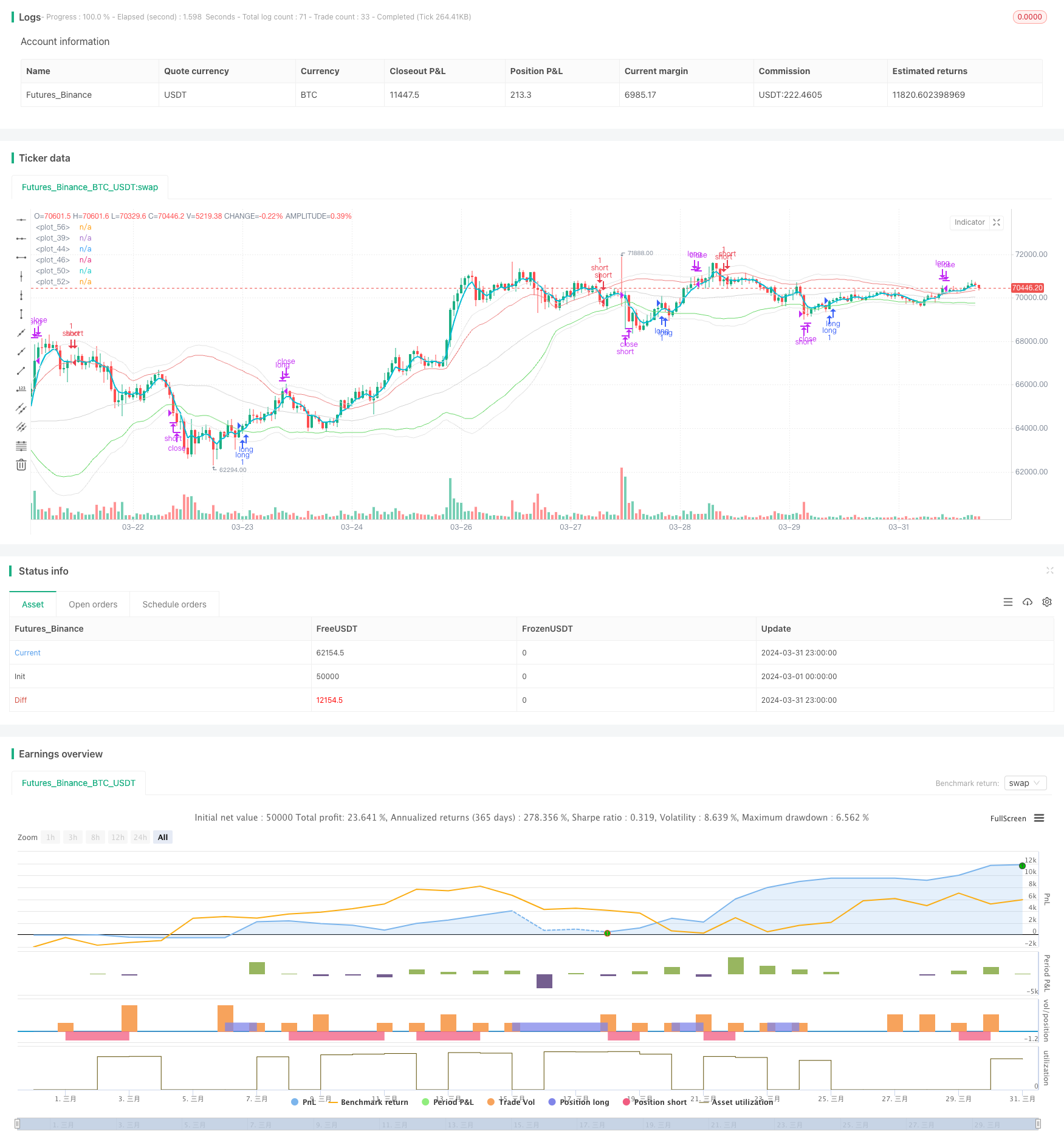
概述
该策略主要利用滑动平均线和布林带来捕捉市场的趋势和波动。策略中使用了三种不同的移动平均线:简单移动平均线(SMA)、加权移动平均线(WMA)和指数移动平均线(EMA)。同时利用布林带来设定价格通道,上下轨分别作为开仓和平仓的信号。当价格突破布林带上轨时开空仓,突破下轨时开多仓。同时设置了更宽的布林带作为止损位,当价格突破止损布林带时平仓。总的来说,该策略试图在趋势产生时及时建仓,在风险加大时果断止损,以期获得稳定的收益。
策略原理
- 计算三种不同周期的移动平均线:慢速SMA、快速EMA和中速WMA,分别反映市场的长期、短期和中期趋势。
- 根据价格标准差计算两组布林带:开仓布林带(上下轨距离较近)和止损布林带(上下轨距离较宽)。开仓布林带用于开仓,止损布林带用于平仓止损。
- 当快速EMA上穿开仓布林带上轨时,开空头仓位;当快速EMA下穿开仓布林带下轨时,开多头仓位。这意味着价格偏离均值较多,趋势可能产生。
- 一旦开仓后,如果价格进一步上穿止损布林带上轨,则平掉所有多头仓位;如果价格进一步下穿止损布林带下轨,则平掉所有空头仓位。这是为了控制损失,一旦趋势反转即果断止损。
- 以上过程不断循环,使得策略可以根据市场趋势灵活调整仓位,并及时止损,以期实现稳健的收益。
策略优势
- 考虑了三种不同速度的移动平均线,全面捕捉各种级别的市场趋势。
- 引入布林带作为开平仓条件,可以根据市场波动率动态调整,灵活应对行情。
- 设置止损布林带,控制回撤,并在市场剧烈波动时果断平仓,避免损失扩大。
- 逻辑清晰,规则简单,易于实现和优化。
- 适用范围广,对多种市场、多个时间周期都可能有效。
策略风险
- 在震荡市中,频繁开平仓可能导致大量交易成本,从而侵蚀利润。
- 趋势转折初期,策略可能仍然按原趋势方向交易,造成一定损失。
- 对于极端行情,如价格快速跳空,止损布林带可能无法很好地控制风险。
- 参数选择不当(如移动平均线周期、布林带宽度等)可能使策略失效。
- 如果市场持续震荡,策略可能长期无法捕捉到明显的趋势机会。
策略优化方向
- 适当增大移动平均线周期和布林带宽度参数,以减少在震荡市中的交易频率和成本。
- 引入更多技术指标或市场情绪指标作为过滤,以提高开仓信号的精度,避免在趋势初期可能出现的亏损交易。
- 对极端行情设置特殊规则,如跳空时暂停开新仓等,以控制风险。
- 对参数进行优化,找到最适合当前市场的参数组合,提高策略的稳健性。
- 增加仓位管理和资金管理规则,如根据趋势强度或盈利情况调整仓位,设置总体止损线等,进一步控制策略风险。
总结
Marina Parfenova学校项目机器人是一个基于滑动平均线和布林带的量化交易策略。它试图通过捕捉市场趋势获利,同时通过布林带止损线控制回撤。策略逻辑简单明了,适用范围广泛,可以根据市场特点灵活调整参数。但在实际应用中仍需注意震荡市、极端行情、参数优化等问题,并进一步细化资金管理和仓位管理规则。总的来说,该策略可以作为一个基础的量化交易框架,在此基础上可以不断优化和改进,以期获得更稳健的交易效果。
策略源码
/*backtest
start: 2024-03-01 00:00:00
end: 2024-03-31 23:59:59
period: 1h
basePeriod: 15m
exchanges: [{"eid":"Futures_Binance","currency":"BTC_USDT"}]
*/
//@version=5
strategy ("Marina Parfenova School Project Bot", overlay = true)
sma(price, n) =>
result = 0.0
for i = 0 to n - 1
result := result + price [i] / n
result
wma(price, n) =>
result = 0.0
sum_weight = 0.0
weight = 0.0
for i = 0 to n - 1
weight := n - 1
result := result + price [i]*weight
sum_weight := sum_weight + weight
result/sum_weight
ema(price, n) =>
result = 0.0
alpha = 2/(n + 1)
prevResult = price
if (na(result[1]) == false)
prevResult := result[1]
result := alpha * price + (1 - alpha) * prevResult
/// Настройки
n_slow = input.int(50, "Период медленной скользящей средней", step=5)
n_fast = input.int(4, "Период быстрой скользящей средней")
n_deviation = input.int(30, "Период среднеквадратического отклонения", step=5)
k_deviation_open = input.float(1.2, "Коэффициент ширины коридора покупки", step=0.1)
k_deviation_close = input.float(1.6, "Коэффициент ширины коридора продажи", step=0.1)
// ----- Линии индикаторов -----
// Медленная скользящая
sma = sma(close, n_slow)
plot(sma, color=#d3d3d3)
// Линии Боллинджера, обозначающие коридор цены
bollinger_open = k_deviation_open * ta.stdev(close, n_deviation)
open_short_line = sma + bollinger_open
plot(open_short_line, color=#ec8383)
open_long_line = sma - bollinger_open
plot(open_long_line, color=#6dd86d)
bollinger_close = k_deviation_close * ta.stdev(close, n_deviation)
close_short_line = sma + bollinger_close
plot(close_short_line, color=#e3e3e3)
close_long_line = sma - bollinger_close
plot(close_long_line, color=#e3e3e3)
// Быстрая скользящая
ema = ema(close, n_fast)
plot(ema, color = color.aqua, linewidth = 2)
// ----- Сигналы для запуска стратегии -----
// если ema пересекает линию open_short сверху вниз - сигнал на создание ордера в short
if(ema[1] >= open_short_line[1] and ema < open_short_line)
strategy.entry("short", strategy.short)
// если ema пересекает линию open_long снизу вверх - сигнал на создание ордера в long
if(ema[1] <= open_long_line[1] and ema > open_long_line)
strategy.entry("long", strategy.long)
// если свеча пересекает верхнюю линию коридора продажи - закрываем все long-ордера
if (high >= close_short_line)
strategy.close("long")
// если свеча пересекает нижнюю линию коридора продажи - закрываем все short-ордера
if (low <= close_long_line)
strategy.close("short")
相关推荐